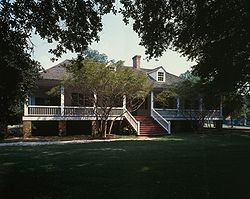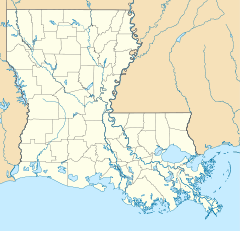- Magnolia Mound Plantation House
-
Magnolia Mound Plantation House
 Front of the house
Front of the houseLocation: 2161 Nicholson Dr., Baton Rouge, Louisiana Coordinates: 30°25′34″N 91°11′13″W / 30.42611°N 91.18694°WCoordinates: 30°25′34″N 91°11′13″W / 30.42611°N 91.18694°W Built: 1786 Architectural style: Colonial, Other Governing body: Local NRHP Reference#: 72000549 Added to NRHP: September 7, 1972[1] The Magnolia Mound Plantation House is a French Creole house constructed in 1791 near the Mississippi River in Baton Rouge, Louisiana.[2] Many period documents refer to the plantation as Mount Magnolia. The house and several original outbuildings on the grounds of Magnolia Mound Plantation are examples of the vernacular architectural influences of early settlers from France and the West Indies.[3] The complex is owned by the city of Baton Rouge and maintained by its Recreation Commission (BREC). It is located approximately one mile south of downtown. The house was listed on the National Register of Historic Places in 1972.[1]
Contents
Early history
The plantation house, first a cottage, was one of the earliest buildings in the city of Baton Rouge. The land was owned originally by James Hillin, an early Scots settler who arrived in 1786, who lived there with wife Jane Stanley Hillin, five children, and six enslaved Africans: Thomas, John, Lucia, Catherine, Jenny, and Anna.[4] On December 23, 1791, John Joyce, from Cork County, Ireland, purchased the 950-acre (3.8 km2) property. He, his wife Constance Rochon and their children lived in Mobile, Alabama. By the time of his drowning, on May 9, 1798, during a sailing trip from New Orleans to Mobile, Alabama, Joyce held about 50 slaves at the plantation, who cultivated indigo, tobacco, cotton and sugar cane under supervision of an overseer.[4][5]
The widow Constance Rochon Joyce married the widower Armand Allard Duplantier, an influential person in the city who had four surviving children from his first marriage. She brought 54 slaves to the marriage from her estate.[4] He was a former captain of the Continental Army under the Marquis de Lafayette. They had five children together. From 1802-1805, they enlarged the house to accommodate their large family, although they used it mostly as a country house. M. Duplantier died in 1827.[4]
Duplantier descendants owned the plantation until 1849; the property then had several owners through the late 19th century. At that time Louis Barillier (see portrait) sold the land and improvements to Robert A. Hart.[6]
After the Civil War
Edward J. Gay purchased the deed in the early 1860s and had several overseers run the plantation for him, including for years after the American Civil War. In 1869 the manager was W.L. Larimore.
In the 20th century, Mrs. Blanche Duncan acquired Magnolia Mound Plantation through a family inheritance. In 1951, Mrs. Duncan commissioned the architectural firm of Goodman and Miller of Baton Rouge to do extensive alterations and additions.
After the property fell into disrepair, in 1966 the city of Baton Rouge exercised eminent domain to purchase the house and 16 acres (65,000 m2) to preserve the house and buildings for their historic and architectural value. The property is a green space within the city.
Architecture
The cottage was originally four rooms, with side-by-side room arrangement.[2] About 1812 it was expanded to a seven or eight-room house, including an extension for a formal dining room and two service rooms.[4] A "U-shaped" gallery was constructed during this second stage of development. The Duplantier family used it as a country house.
During the late 19th century, owners added rooms under the gallery on the north and south sides. The basic form of the house is rectangular with a large hip roof, which covers all rooms and galleries. During the early 19th century, double-hung windows were added.
The interior décor was altered during the early 20th century.
In 1998, the city installed an original, double slave cabin (c.1830) from Pointe Coupee Parish on the grounds to help interpret the lives of enslaved Africans. One half is furnished as it would have been in the early 19th century; the other half has an exhibit on slave life in Louisiana.[4]
Additional outbuildings, some original to the plantation, show how the operations of the plantation were supported:
Open-hearth kitchen- The city reconstructed a separate outdoor kitchen building based on archaeological evidence. It is authentically furnished with vintage utensils, such as spider pots, a clock-jack, sugar nippers, waffle iron, olla jar and reflector ovens.Overseer's House- original to the plantation, c. 1870.
Crop Garden- the crop garden contains indigo, tobacco, cotton, and sugar cane to depict Magnolia Mound's cash crops throughout its history.
Pigeonnier- A small pigeon house or dovecote, c.1825, typical of French Creole plantations, to house squab and various game birds.[7] Today it again houses a collection of live pigeons.
Carriage House- Holds a collection of vintage tools, as well as a weaver's workshop, that depict plantation chores c.1800-1820.[8]
References
 This article incorporates public domain material from the National Park Service document "[1]".
This article incorporates public domain material from the National Park Service document "[1]".- ^ a b "National Register Information System". National Register of Historic Places. National Park Service. 2008-04-15. http://nrhp.focus.nps.gov/natreg/docs/All_Data.html.
- ^ a b Edwards, Jay D. (1994). "The Origins of Creole Architecture". Winterthur Portfolio, (Winterthur Portfolio, Vol. 29, No. 2/3) 29 (2/3): 155–189. doi:10.1086/496659. JSTOR 1181485.
- ^ "Magnolia Mound Plantation". BREC. http://www.brec.org/index.cfm?md=pagebuilder&tmp=home&nid=659&cpid=387&cfmid=0&catid=0. Retrieved 2008-08-12.
- ^ a b c d e f Rose, Julia Anne (August 2006). Rethinking Representations Of Slave Life At Historical Plantation Museums: Towards A Commemorative Museum Pedagogy. Baton Rouge: Louisiana State University. pp. 32–33. http://etd.lsu.edu/docs/available/etd-06292006-183004/unrestricted/Rose_dis.pdf. p. 21
- ^ "The Cottage on the Mound". duplantier.org. http://www.duplantier.org/cottage_on_the_mound.html. Retrieved 2008-08-12.
- ^ "Louis Barillier, East Baton Parish, Louisiana". Biographical and Historical Memoirs of Louisiana. http://files.usgwarchives.org/la/eastbatonrouge/bios/barillie.txt. Retrieved 2008-08-12.
- ^ The New Cassell's French Dictionary, New York: Funk & Wagnalls, 1973, p. 563
- ^ "Magnolia Mound Plantation", Baton Rouge Recreation and Park Commission, accessed 5 Sep 2009
External links
- "Magnolia Mound Plantation House", National Park Service
U.S. National Register of Historic Places Topics Lists by states Alabama • Alaska • Arizona • Arkansas • California • Colorado • Connecticut • Delaware • Florida • Georgia • Hawaii • Idaho • Illinois • Indiana • Iowa • Kansas • Kentucky • Louisiana • Maine • Maryland • Massachusetts • Michigan • Minnesota • Mississippi • Missouri • Montana • Nebraska • Nevada • New Hampshire • New Jersey • New Mexico • New York • North Carolina • North Dakota • Ohio • Oklahoma • Oregon • Pennsylvania • Rhode Island • South Carolina • South Dakota • Tennessee • Texas • Utah • Vermont • Virginia • Washington • West Virginia • Wisconsin • WyomingLists by territories Lists by associated states Other  Category:National Register of Historic Places •
Category:National Register of Historic Places •  Portal:National Register of Historic PlacesCategories:
Portal:National Register of Historic PlacesCategories:- Buildings and structures in Baton Rouge, Louisiana
- Houses on the National Register of Historic Places in Louisiana
- Historic house museums in Louisiana
- Plantations in Louisiana
- Museums in Baton Rouge, Louisiana
Wikimedia Foundation. 2010.

